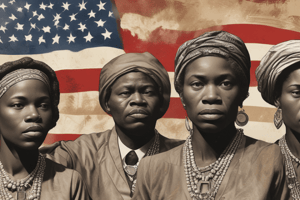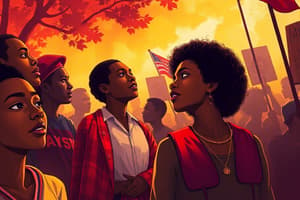Podcast
Questions and Answers
What was the main goal of the Civil Rights Movement?
What was the main goal of the Civil Rights Movement?
- To establish a separate nation for African Americans
- To promote black nationalism and separate communities
- To advocate for women's rights and gender equality
- To end racial segregation and discrimination against African Americans (correct)
Who led the Montgomery Bus Boycott?
Who led the Montgomery Bus Boycott?
- Thurgood Marshall
- Dr. Martin Luther King Jr. (correct)
- Malcolm X
- Rosa Parks
What was the name of the famous speech delivered by Dr. Martin Luther King Jr. during the March on Washington?
What was the name of the famous speech delivered by Dr. Martin Luther King Jr. during the March on Washington?
- Freedom Now
- Give Me Liberty
- I Have a Dream (correct)
- We Shall Overcome
What was the outcome of the Freedom Rides?
What was the outcome of the Freedom Rides?
Who was the first African American to serve on the Supreme Court?
Who was the first African American to serve on the Supreme Court?
What did the Civil Rights Act of 1964 prohibit?
What did the Civil Rights Act of 1964 prohibit?
What did the Fair Housing Act of 1968 prohibit?
What did the Fair Housing Act of 1968 prohibit?
What social movement was inspired by the Civil Rights Movement?
What social movement was inspired by the Civil Rights Movement?
What is the name of the contemporary social justice movement that was influenced by the Civil Rights Movement?
What is the name of the contemporary social justice movement that was influenced by the Civil Rights Movement?
When did the Civil Rights Movement take place?
When did the Civil Rights Movement take place?
Flashcards are hidden until you start studying
Study Notes
Overview
- The Civil Rights Movement was a social movement in the United States that aimed to end racial segregation and discrimination against African Americans.
- The movement took place from the mid-1950s to the late 1960s.
Key Events
- Montgomery Bus Boycott (1955-1956): Sparked by Rosa Parks' refusal to give up her seat to a white person, led by Dr. Martin Luther King Jr.
- Greensboro Sit-Ins (1960): Nonviolent protests at a segregated lunch counter in North Carolina, led by four African American college students.
- Freedom Rides (1961): Interracial groups of activists rode buses through the South to test desegregation, facing violence and arrest.
- March on Washington (1963): Hundreds of thousands gathered in Washington, D.C. to advocate for civil and economic rights, where Dr. King delivered his "I Have a Dream" speech.
Key Figures
- Dr. Martin Luther King Jr.: Leader of the movement, advocated for nonviolent civil disobedience.
- Rosa Parks: Symbol of resistance against segregation, sparked the Montgomery Bus Boycott.
- Malcolm X: Advocate for black nationalism, converted to Islam and became a prominent figure before his assassination in 1965.
- Thurgood Marshall: First African American to serve on the Supreme Court, argued several landmark civil rights cases.
Legislation and Outcomes
- Civil Rights Act of 1964: Prohibited discrimination based on race, color, religion, sex, or national origin.
- Voting Rights Act of 1965: Protected African Americans' right to vote, outlawing literacy tests and poll taxes.
- Fair Housing Act of 1968: Prohibited discrimination in the sale, rental, and financing of housing.
Impact and Legacy
- The Civil Rights Movement achieved significant legal and social changes, ending segregation and discrimination.
- Inspired social movements for women's rights, LGBTQ+ rights, and disability rights.
- Continues to influence contemporary social justice movements, such as Black Lives Matter.
Overview
- The Civil Rights Movement was a social movement in the United States that aimed to end racial segregation and discrimination against African Americans from the mid-1950s to the late 1960s.
Key Events
- Montgomery Bus Boycott (1955-1956): Rosa Parks' refusal to give up her seat to a white person sparked a 381-day boycott, led by Dr. Martin Luther King Jr., resulting in the Supreme Court ruling that segregation on public buses is unconstitutional.
- Greensboro Sit-Ins (1960): Four African American college students, Ezell Blair Jr., David Richmond, Franklin McCain, and Joseph McNeil, staged nonviolent protests at a segregated lunch counter in North Carolina, sparking similar protests across the South.
- Freedom Rides (1961): Interracial groups of activists rode buses through the South to test desegregation, facing violence and arrest, which drew international attention to the Civil Rights Movement.
- March on Washington (1963): Hundreds of thousands gathered in Washington, D.C. to advocate for civil and economic rights, where Dr. King delivered his iconic "I Have a Dream" speech.
Key Figures
- Dr. Martin Luther King Jr.: Leader of the movement, advocated for nonviolent civil disobedience, and became a prominent figure in the movement.
- Rosa Parks: Symbol of resistance against segregation, sparked the Montgomery Bus Boycott, and became an iconic figure in the movement.
- Malcolm X: Advocate for black nationalism, converted to Islam, and became a prominent figure before his assassination in 1965.
- Thurgood Marshall: First African American to serve on the Supreme Court, argued several landmark civil rights cases, including Brown v. Board of Education.
Legislation and Outcomes
- Civil Rights Act of 1964: Prohibited discrimination based on race, color, religion, sex, or national origin in employment, education, and public accommodations.
- Voting Rights Act of 1965: Protected African Americans' right to vote, outlawing literacy tests and poll taxes, and authorized federal supervision of elections.
- Fair Housing Act of 1968: Prohibited discrimination in the sale, rental, and financing of housing based on race, color, religion, sex, or national origin.
Impact and Legacy
- The Civil Rights Movement achieved significant legal and social changes, ending segregation and discrimination against African Americans.
- Inspired social movements for women's rights, LGBTQ+ rights, and disability rights.
- Continues to influence contemporary social justice movements, such as Black Lives Matter, and remains a crucial part of American history and identity.
Studying That Suits You
Use AI to generate personalized quizzes and flashcards to suit your learning preferences.




